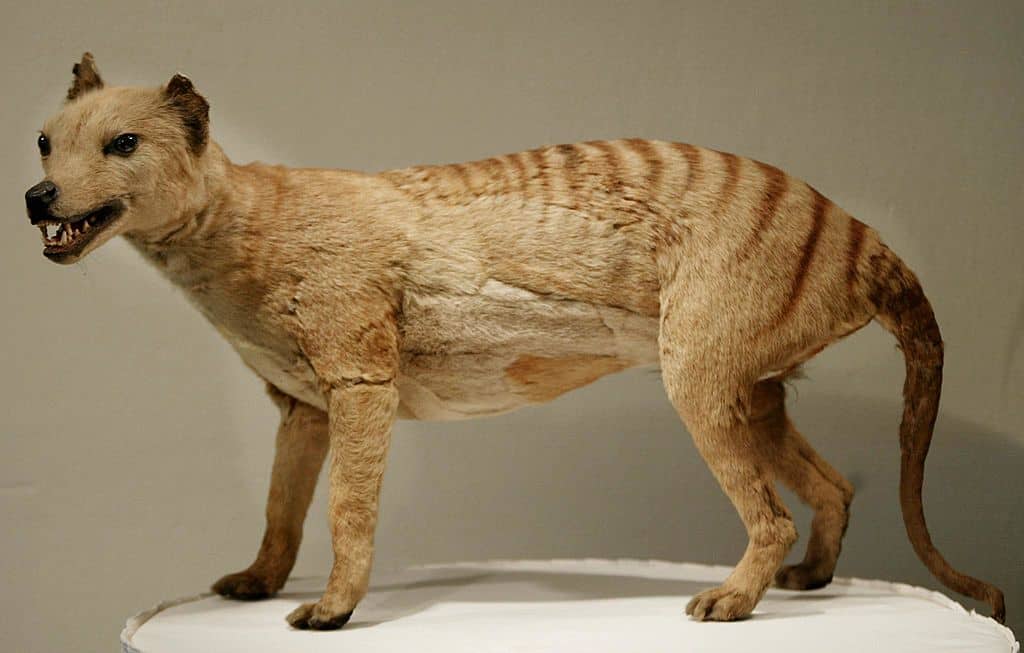Unlock the Secrets of the Australian Tasmanian Tiger
Hello, adventurous parents and curious kiddos! Have you ever heard whispers of a striped, wolf-like creature prowling the wilds of Tasmania? Well, strap in for a fantastic journey into the world of the Australian Tasmanian Tiger, also known as the thylacine. This guide is a treasure trove of information that will captivate your family’s imagination and inspire you to learn more about one of Australia’s most mysterious historical creatures!
What Is the Australian Tasmanian Tiger?
The Australian Tasmanian Tiger, or thylacine, was a carnivorous marsupial that once roamed the dense forests and bushland of Tasmania, Australia’s island state. With its slender, dog-like body, haunting yellow-brown eyes, and distinctive dark stripes across its back, the thylacine has intrigued people globally. But here’s the catch – this enigmatic animal is thought to have become extinct in the 20th century. Or has it? Rumors of sightings still ignite the imagination of believers and skeptics alike!
The Historical Habitat of the Thylacine
Originally found across continental Australia, Tasmania, and New Guinea, this solitary predator was a master of its domain. The thylacine preferred eucalyptus forests, wetlands, and grasslands, where it could hunt and rear its young in dense vegetation, away from prying eyes. Over time, largely due to human activity, their numbers dwindled, and the focus of their existence centered around Tasmania, thus earning them the iconic name Tasmanian Tiger.
The Fascinating Anatomy of an Apex Predator
As we delve into the wild world of the thylacine, it’s essential to admire its unique biological features. The Tasmanian Tiger was no ordinary mammal; it was a marsupial, like kangaroos and koalas, meaning it raised its young in a pouch. With a jaw that could open nearly 80 degrees and a set of 46 sharp teeth, the thylacine was truly a spectacle of natural engineering. But wait until you hear about its stomach pouch that both males and females had – talk about a parenting plot twist!
Exploring the Thylacine’s Diet and Hunting Habits
Clear the table and make room for the wild diet of the Tasmanian Tiger. The thylacine was primarily a nocturnal hunter, preferring to sneak up on its prey under the cover of darkness. It feasted on kangaroos, wallabies, birds, and small animals, showcasing its versatility in adapting to the available food sources. Scientists and researchers are still unraveling the mysteries of its hunting tactics and behaviors, and we’ll dig into that in the next sections of this guide.
Thylacine Extinction: A sobering tale
The story of the Tasmanian Tiger is not just a tale of wonder but also a sobering account of human impact on the environment. Due to factors such as habitat destruction, competition with wild dogs, and relentless hunting fueled by government bounties, the thylacine’s numbers rapidly diminished. The last known thylacine died in Hobart’s Beaumaris Zoo in 1936, a day marked by both sadness and reflection. Yet, the legacy of the Tasmanian Tiger lives on, reminding us of the delicate balance we share with Earth’s precious wildlife.
But the adventure doesn’t stop here! In the upcoming sections, we’ll uncover the ongoing search for the thylacine, conservation efforts to protect Tasmania’s unique ecosystem, and fun activities you and your family can do to explore the legend of the Tasmanian Tiger. We’ll examine the cultural impact this creature had on the people of Australia and the faint hope among enthusiasts that the thylacine may still roam Tasmania’s wilderness.
Get ready to dive deeper into the natural history and the fascinating world of the Australian Tasmanian Tiger. Keep the spirit of exploration alive as we embark on this educational odyssey together. Stay tuned, as more wonder-filled discoveries await!

5 Important Things Parents Should Know When Preparing to Explore the World of the Australian Tasmanian Tiger
1. Understanding Extinction and Conservation
Parents, it’s crucial to equip your little explorers with the understanding of extinction and the importance of conservation. Discussing the thylacine’s story provides a valuable lesson on how human actions can impact wildlife. It’s an opportunity to educate your children on the significance of biodiversity and the need to protect the natural habitats of animals. Instill a sense of responsibility and enthusiasm for the environment as you delve into the tale of the thylacine.
2. Embrace the Mystery and Keep an Open Mind
When venturing into the history of the Tasmanian Tiger, embrace the air of mystery that surrounds it. Use this as an occasion to teach your children about scientific inquiry and critical thinking. Encourage them to ask questions, consider different perspectives, and appreciate the ongoing research. You never know, you might ignite a spark of passion for science and discovery in your young ones!
3. Cultivate Respect for Indigenous Stories and Culture
The thylacine is not only a part of Tasmania’s natural history but also its cultural heritage. Indigenous Tasmanian stories and art offer a rich tapestry of information and respect for the thylacine. Share with your children the importance of honoring Indigenous perspectives, and the deep connection they hold with the land and its creatures. This understanding promotes cultural awareness and empathy.
4. Prepare for an Educational Adventure
Whether you’re venturing into the outdoors or exploring from the comfort of your home, turn your thylacine journey into an exciting and educational adventure. Prepare activities such as wildlife tracking, nature walks, or even a thylacine treasure hunt. Through play and discovery, your kids can learn about animal behavior, the environment, and the history of scientific knowledge in a fun, engaging way.
5. Promote Hope and Active Participation in Wildlife Causes
While the thylacine’s tale may end in what seems to be tragedy, it can also serve as a powerful motivator for hope and action. Involve your family in local conservation efforts or support organizations that work to protect wildlife. Taking part in citizen science projects or simply having conversations about endangered species raises awareness and contributes to conservation efforts, giving your child a sense of empowerment and the knowledge that they can make a difference.
Join the Quest: Is the Thylacine Still Out There?
Many people, including scientists and adventure-seekers, have not given up hope that the thylacine might still be found in the wild. Numerous unconfirmed sightings and the sheer vastness of Tasmania’s wilderness fuel the speculation that the thylacine might still linger in some hidden corner of the island. Engage with your children in this real-life detective story by reading up on the latest research, exploring maps, and even taking part in respectful discussions about possible evidence of the thylacine’s existence.
Exploring Tasmania’s Ecosystem
Tasmania is a living classroom, teeming with unique flora and fauna. Your family can learn about the different species that shared the habitat with the thylacine and those that continue to thrive in the region. Understanding the delicacy of these ecosystems is vital, and by learning about Tasmania’s environment, your children will gain a deeper respect and love for the natural world. Who knows, they might also develop keen observational skills and learn to notice the often-overlooked details that make nature so fascinating.
Stay tuned as we venture further into this remarkable chapter of natural history, and together, let us keep the story of the Australian Tasmanian Tiger alive for generations to come!
For more great fun click here. For more information see here
Disclaimer
The articles available via our website provide general information only and we strongly urge readers to exercise caution and conduct their own thorough research and fact-checking. The information presented should not be taken as absolute truth, and, to the maximum extent permitted by law, we will not be held liable for any inaccuracies or errors in the content. It is essential for individuals to independently verify and validate the information before making any decisions or taking any actions based on the articles.




